May 18 - 24, 2014: Issue 163
Fred Verrills – Builder of Bridges and Roads Within Australia During WWII – Builder of Palm Beach Thereafter
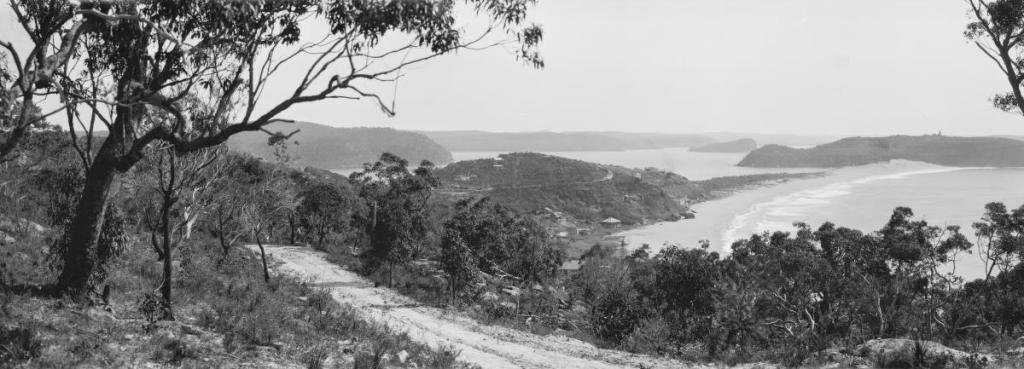
Section from below: Panorama of Palm Beach, New South Wales, Part of Enemark collection of panoramic photographs [1917-1946] nla.pic-vn6195143, courtesy National Library of Australia.

Many of our AIF servicemen were assessed for skills they had as civilians when enlisting to serve as part of the A.I.F. If they had knowledge and experience in areas that were vital to defending Australia’s home soil, they were kept here rather then being sent overseas to the many conflicts raging in Europe and Asia.
Australia underwent a massive road building and bridge building exercise during the whole of the World War II years – there simply weren’t the roads or kind of roads needed to defend our perimeters or transport men, supplies and equipment through the interior areas.
One of these groups were known as the Civil Construction Corps, the other was the Royal Australian Engineers.
Before WWII, the ‘road’ south from Darwin was an unsealed track that became a quagmire in the wet and a dust bowl in the dry. With the escalation of the Japanese threat to Northern Australia and surrounding sea lanes the authorities realised a road linking Darwin with the south had to be constructed to supply the top end in the event of a prolonged attack by the Japanese.
The construction of the Alice Springs-Darwin Road constituted an engineering feat of considerable magnitude and of great military importance. As sections of the 1000 mile all-weather road was completed, convoys moved supplies between Alice Springs and Darwin.
Road construction gangs from the Main Roads Departments of Queensland, New South Wales, South Australia and the Commonwealth Department of the Interior were tasked to construct a road between Birdurn/Larrimah - the terminus for the North Australian Railway - and Alice Springs. The 600 miles of roadworks commenced in September 1940 and a formed road was completed in three months. However, the wet season of 1940-41 took its toll and it was realised that a bitumen all-weather road with bridges across creeks was essential.
Large petrol dumps had to be established near staging points as fuel usage was high due to the evaporation rate from drums exposed to sun and high temperatures, and heavy fuel consumption from head winds and high loads.
Over four years the continuous stream of well-organised convoys collectively drove about 100 million miles and moved almost 200,000 troops, their food and supplies.
The 600-mile road through the middle of Australia provided Darwin and the top end with a lifeline. Retrieved From: www.anzacday.org.au/history/ww2/bfa/dusty_track.html
This is a record of one of our Pittwater originals, Frederick Leonard Verrills, son of Albert and father of Peter, who was part of this massive exercise and returned to Palm Beach to become one of our builders, working on projects such as the award winning House of the Year of 1957 in Byna Road. We thank his son Peter Verrills, and Peter’s persistence in asking questions when he could, for bringing you a small insight into another quiet achiever.
THE SON and daughter of two of the oldest families in Palm Beach were married at the Manse, Clareville, last Saturday afternoon. They were Mr. Frederick Verrals, younger son of Mr. and Mrs. A. Verrals, who were the first residents of Palm Beach, and the bride was Miss Nell Gonsalve, youngest daughter of Mr. and Mrs. H. Gonsalve, of Palm Beach. Mr. and Mrs. Gonsalve used to travel to Palm Beach by boat long before a road was built through. Mrs. A. Goddard, also of Palm Beach, was matron of honor. After the reception, which was held at the Palm Beach Golf Club, the bride and bridegroom left for the honeymoon on the yacht Carlo, which was followed by a fleet of motor boats and yachts down to West Head, Barrenjoey. Smart Set At The Tennis (1937, January 31). The Sun (Sydney, NSW : 1910 - 1954), p. 34. Retrieved from http://nla.gov.au/nla.news-article230794137
Peter, when were you born?
Born 21st of May, 1939. I was born in Waratah street, Palm Beach. My granny Gonsalves delivered me. Dad was away in the Army and so mum lived with her parents in their home while he was away. When the Gonsalves first arrived they settled on what we call today ‘Portuguese Beach’; they were coming here for around three years before they moved in permanently here. They’d row around every Summer because old Goni was a fisherman and Mrs Gonsalves was a Walter from the Newcastle ferry family from Stockton, how they met I don’t know, but he probably went up and down the coast fishing, and they settled over on Portuguese Beach. They were a Portuguese family, the Gonsalves, and that’s how it has got its name; Portuguese. The authorities eventually got them off out of there and they then bought land in Waratah street also. She set up a dairy there and grew veggies and everything to supply the weekenders with milk and veggies, and all the golf course here; they had that as agistment for their stock. In some of the old photos you’ll see cows wandering around on it. The Gonsalves and Verrills have all inter-married, and then the Goddards.
I went to Newport school too; I’ll never forget it, the camouflage bus. All the windows were blackened out, everything had to be blacked out then; no street lights, no nothing. I only got to know dad from when I was about seven years old because he was in the Army and I was born just prior to the war starting.
Not long after that he got a War Service loan so we moved to almost opposite the Gilberts, in Careel Bay. He started building there. He got an army tent, he put that up, and he built a shed there and we lived in that while he was building the house.
Was Fred (Freddy) apprenticed to Albert?
Peter: Yep. His original name in Palm Beach was Freddy the Fruiterer.
Why?
Because all of the produce that Mrs Gonsalves grew. Freddy had a horse and sulky, and he’d go around everywhere every weekend, and we’re talking about a 12 or 14 year old here, and flog fruit and veggies to all the weekenders.
As kids we’d be up at daylight and then you’d hear the cowbell and know you had to come home for something to eat and then of you’d go again; doing something else. So he was Freddy the Fruiter and then went to work with his dad after he left school at Newport. He used to have to go on the launch there originally but before he finished the road had gone through. There was the Mullhalls (lighthouse children), the Goddards, the Stiles over at Currawong, He went on a bit longer in school.
What was Fred like?
He was a bloody rogue too, like his old man.
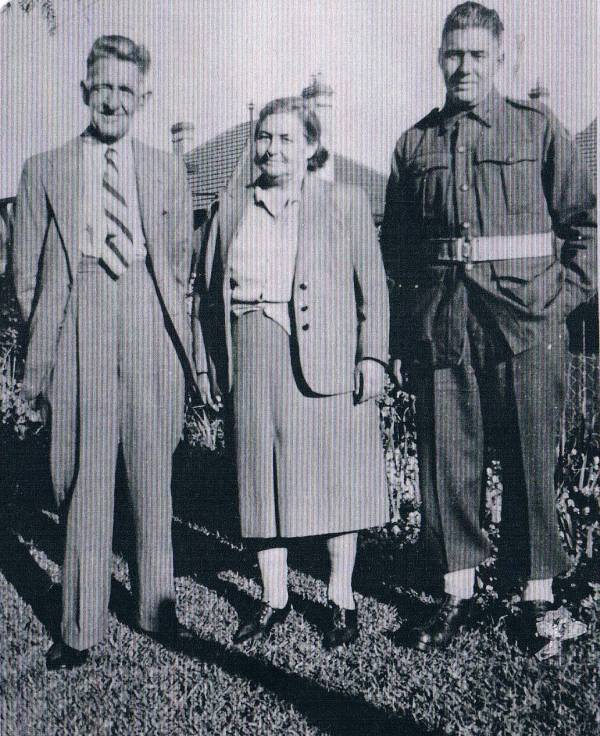 He spent a lot of time in the Army; he was in Geraldton and Darwin and Broome. He went in in 1939; I have no recollections of him until afterwards, until he came home from the war. He was part of the 52nd Field Park; they were building air strips and bridges and roads through west Australia and Geraldton. Then they were sent up into Darwin when Darwin got bombed; they were sent in to rebuild everything.
He spent a lot of time in the Army; he was in Geraldton and Darwin and Broome. He went in in 1939; I have no recollections of him until afterwards, until he came home from the war. He was part of the 52nd Field Park; they were building air strips and bridges and roads through west Australia and Geraldton. Then they were sent up into Darwin when Darwin got bombed; they were sent in to rebuild everything.
VERRILLS FREDERICK LEONARD : Service Number - NX88722 : Date of birth - 28 Dec 1915 : Place of birth - NTH SYDNEY NSW : Place of enlistment - PADDINGTON NSW : Next of Kin - VERRILLS ELLEN - Second Australian Imperial Force Personnel Dossiers, 1939-1947
Left: Ernie with his dad Albert and mum Florence.
Ernest Albert Verrills (Born 1911) to Albert and Florence Verrills, and elder brother to Fred, is listed: AUSTRALIAN ENGINEERS - 52nd Field Park Coy., R.A.E., A.I.F. See: www.collectingbooksandmagazines.com/52nd.html and a few records on the Australian War Memorial website HERE. It seems, by their allocated enlistment numbers, that they went and enlisted together and were sent to the same service area as well:
VERRILLS ERNEST ALBERT : Service Number - NX88723 : Date of birth - 22 Sep 1912 : Place of birth - NTH SYDNEY NSW : Place of enlistment - PADDINGTON NSW : Next of Kin - VERRILLS WINIFRED
And were still a team when they came home:
Warringah Council minutes - 31.5.1958
Transfers (2) releasing Easement to Ernest Albert Verrills and Frederick Leonard Verrills (tenants in common) with respect to Drainage Easement in favour of the Council affecting Lot 42 D.P. 17189 Whale Beach Road, North Avalon.
Ernest (Ernie) passed away in 1962.
My recollections of dad; we knew he was coming home and I would have been six years old then, and I recall going to Ingleburn because they were all shipped to Ingleburn and then the families were to meet them there. I just remember all these soldiers; paddocks and paddocks of soldiers.. and then the Passing Out Parade and everyone collecting their husbands and getting in whatever old bombs were around to get home. And that was when I first met dad.
We came back to the Gonsalves; I was born in Waratah street here; we came back here because mum (Nellie Gonslaves) lived with her mum and dad while the old man was in the Army. He then got a War Service loan and built down opposite the Gilberts at Careel Bay.
Did your dad ever tell you any stories about Darwin?
Peter; He never ever spoke about any of it…every year they’d have their Army reunion and in the later years, when the numbers were dwindling, the ones that were left were able to bring their sons. We used to go over to Redfern to an RSL club there once a year and I’d drive dad. The blokes that I got introduced to would say ‘your old man did this and your old man did that..’ so I did get a little bit of information out of them but never out of dad.
What did they say?
Oh, just the stupid things he did; stuff about the work ethics. He was in charge, being a builder, of the bridge work and the road constructions and anecdotes about the old machinery they had. They were building with blitz wagons and none of them had brakes. One story they were telling me about the old man; wherever they were, and I think it was around Tennant Creek way somewhere, in convoy, and there was a bit of a hill on it, and the semi behind the old man (they were semi’s but they were only just semis) it was a Chev’ blitz apparently and it’s towing this truck which is fully laden and it ran out of brakes and they knew it was getting too fast and apparently the old man sped his one up, which was only a flat top, and he passed it and got in front of it and put the brakes on. Of course it came up and hit him and then he was able to back it off and they could then grab some gears in the other one and slow it down too. That was one story they told me.
MILNER'S CREEK, NORTHERN TERRITORY, AUSTRALIA. 1944-09-19. A BRIDGE BUILT BY NO. 3 PLATOON, 1ST FIELD COMPANY, ROYAL AUSTRALIAN ENGINEERS TO CARRY THE 8 INCH PIPELINE OVER A GULLY. THE LINE, FABRICATED BY THE 52ND FIELD PARK COMPANY, ROYAL AUSTRALIAN ENGINEERS, RUNS FROM HOWARD SPRINGS TO DARWIN. ID number 080553, courtesy Australian War Memorial
To meet the pressing demand for military vehicles during World War II, several Commonwealth countries designed light armoured vehicles based on CMP chassis made in Canada. They were a Commonwealth vehicle produced in Australia and Canada. The most common truck used by Australia during the war was the blitz truck (not the Opel Blitz, that was German), they were everywhere. They were also widely used in the 1950s and 60s; War surplus. You would find them as rural fire trucks, logging trucks and on farms and many other jobs.
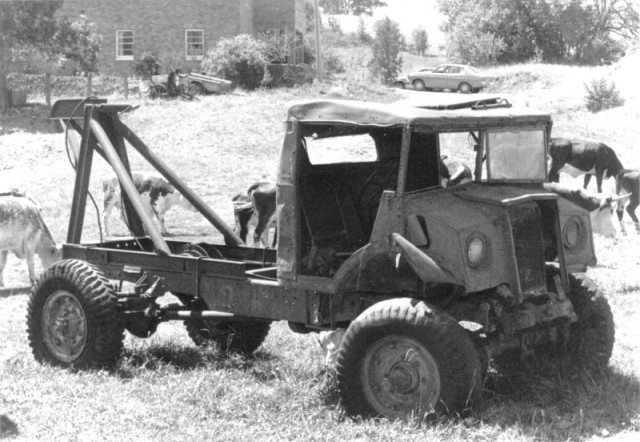
Built in Australia:
Ruskin Motor Bodies Pty Ltd and Ford Motor Company of Australia Rover Light Armoured Car (4x4, 134.25" and 158.25" wheelbases) - built on Ford 3-ton CMP chassis; General Motors Holden Ltd Rhino Heavy Armoured Car (4x4, 101" wheelbase) - prototype only; and General Motors Holden Ltd 6x6 Heavy Armoured Car (6x6, 158" wheelbase)
What was the biggest project he did after he came home?
The biggest project that the old man did, not Albert, but dad (Fred), was Richardson’s, Victor’s; the Round House as we call it, in Dark Gully; as you’re going around the bend there. We were a couple of years there.
Whose idea was that place?
Peter Muller; the architect. The son Gary Richardson had a lot to do with that too; the old man went broke building that place.
Years later Fred diversified and they went out and built homesteads.
Peter: He did a lot of country work. In the 1960’s there was a big, almost Depression virtually, and a slump in the building industry, and all these people that owned houses here in Palm Beach were a lot of cockies; they had rural properties. So we’d go and build a new homestead or manager’s cottage do repair work.
We built the Curlewis’s place (with Albert) around on the beach there and then Ian Joye ended up with that one. Donny Goddard did a lot of work on it and now they’ve had plans passed to change it again; Kahlua it's now known as.
Tom Gilbert: and this place up here on the hill; Percy Spender (with Albert)
Could you name five projects Fred built?
Peter: the Round house (1957) called Kamahl; he did two more for the same architect, Peter Muller, in Byna Road; he built the one with the tree through the middle of it and the one next door. Every single one of his plans were subject, after they were built, to dry rot and every one of them were flat rooved with just bitumen rooves on them and all subject to massive problems, leaked like sieves.
Dad did Pittwater RSL, the original Pittwater RSL, that was 1961. He built the original Moby Dick Club at Whale beach
Muller House in Byna road; 1957 Women's Weekly article:
A progressive council approved the plan under section 50A of the building ordinance, "A very little-used section of the Building Act," says Mr. Muller, "but which allows a council to permit the erection of dwellings of unusual construction." The architect also pays tribute to his builder. Mr. F. A. Verrills, of Palm Beach. "HOUSE OF THE YEAR" AWARD TO HOLIDAY HOME. (1957, July 17). The Australian Women's Weekly (1933 - 1982), p. 27. Retrieved from http://nla.gov.au/nla.news-article47210503 Images: http://nla.gov.au/nla.news-article47210503 + http://nla.gov.au/nla.news-page4827651 + http://nla.gov.au/nla.news-page4827650 + http://nla.gov.au/nla.news-page4827649
Tom Gilbert: He built Miller’s Brewery.
Peter: Yep, Miller’s Brewery, and then when we went to Warragamba Dam to do the Workers Club there; Miller’s supplied the money for that, which was a bloody good job. His rural projects; we went down to Holbrook and did one for the Crawfords who were intermarried with the Veskys; Albert built Elizabeth Cottage here (Palm Beach) for Mrs Crawford and then we built, when they bought a block of land at the side of Elizabeth Cottage, the new one which is right opposite Cynthea road, for them.
From Holbrook we went to Talcutta, the MacTackney’s properties on the Wagga road; built a new homestead there and a manager’s cottage. From there we went to Gunnedah.
When did Fred retire?
He retired about 1973 or ’74. I’d left him just before he retired because I’d had enough of being a builder.
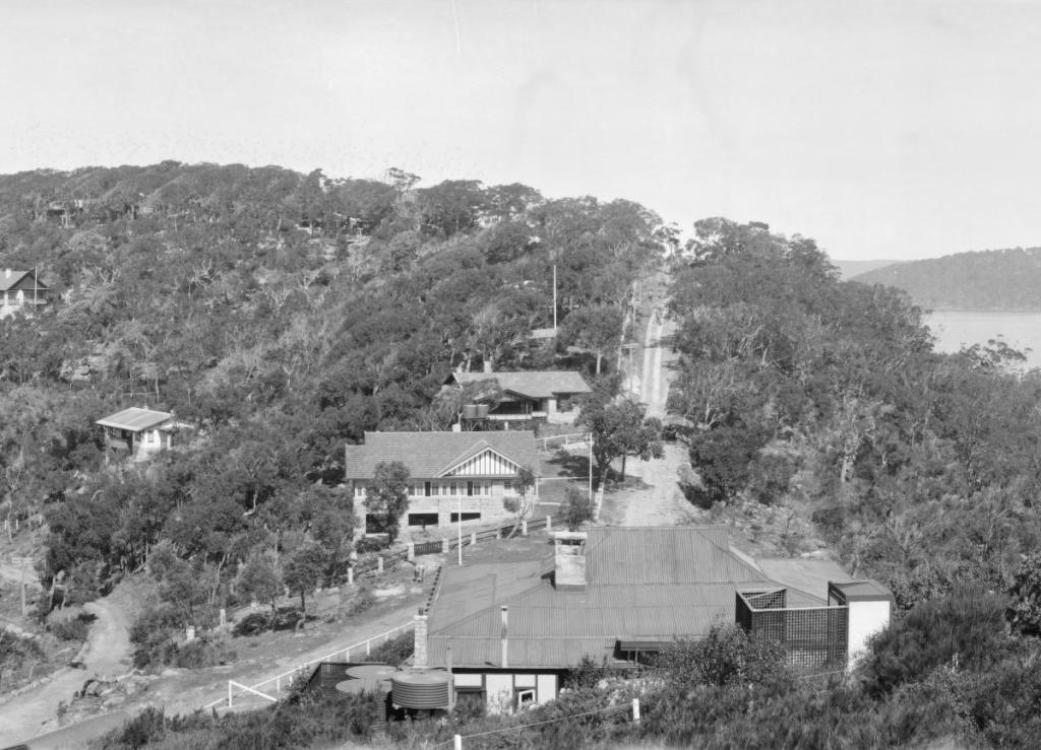
The Maitland home; center of picture built by Albert and his sons, Cnr. of Beach Road and Pacific, Palm Beach. Section from Panorama of Palm Beach, New South Wales, Part of Enemark collection of panoramic photographs [1917-1946] nla.pic-vn6195135, courtesy National Library of Australia.
VERRILLS -May 31 1942 at her residence Reid Street Cremorne Annie dearly loved wife of J G Verrills and fond mother of Emily Bert George Lill Mabel John Jim Len and Arthur aged 78 years. Family Notices. (1942, June 1). The Sydney Morning Herald(NSW : 1842 - 1954), p. 10. Retrieved from http://nla.gov.au/nla.news-article17813110
VERRILLS.-Second-Lieutenant E. J. Verrills, fourth son of J. Verrills, Reed-street, Neutral Bay, killed In France, October 9, 1917. He died a hero for his country's flag. Inserted by his loving parents, brothers, and sisters. Family Notices. (1917, December 1). The Sydney Morning Herald (NSW : 1842 - 1954), p. 11. Retrieved from http://nla.gov.au/nla.news-article15741913
Palm Beach — Concrete Bungalow .' .... :. Wilshire & Day. B. Verrills, Palm Beach. Advertising. (1915, December 17). Construction and Local Government Journal (Sydney, NSW : 1913 - 1930), p. 1. Retrieved from http://nla.gov.au/nla.news-article109633215
B Verrils is ‘Bert’ Verrills – Albert Verrills - for a few insights into 'Wilshire & Day', see: Furlough House Narrabeen - Restful Sea Breezes For Children and Their Mothers
Palm Beach — Concrete Bungalow . WiIshire-& Day. — Derritnan, Rose Bay. Palm Beach — Stone Bungalow. Wilshire & Day. B.Verrills, Palm Beach. Palm Beach — Addits. to House. Wilshire & Day. A. Verrills. Palm Beach. Advertising. (1917, October 2). Construction and Local Government Journal (Sydney, NSW : 1913 - 1930), p. 1. Retrieved from http://nla.gov.au/nla.news-article109674416
Palm Beach— One Brick and One Concrete Bungalow. Wilshire & Day. A. Verrills, Palm Beach. Advertising. (1919, February 24). Construction and Local Government Journal (Sydney, NSW : 1913 - 1930), p. 1. Retrieved from http://nla.gov.au/nla.news-article108990102
Palm Beach— Additions, Palm Beach Surf Club — A. Verrills, Palm Beach. Advertising. (1928, August 22). Construction and Local Government Journal (Sydney, NSW : 1913 - 1930), p. 5. Retrieved from http://nla.gov.au/nla.news-article109727806
TENDERS Supply Steel Girders 1/20 10 \ 4 i/17I 8X4 1/1_3 - ^ 4 1/106 a X 4 1/76x4 ALBERT VERRILLS Palm Beach. Advertising. (1934, September 4). The Sydney Morning Herald(NSW : 1842 - 1954), p. 1. Retrieved from http://nla.gov.au/nla.news-article17078949
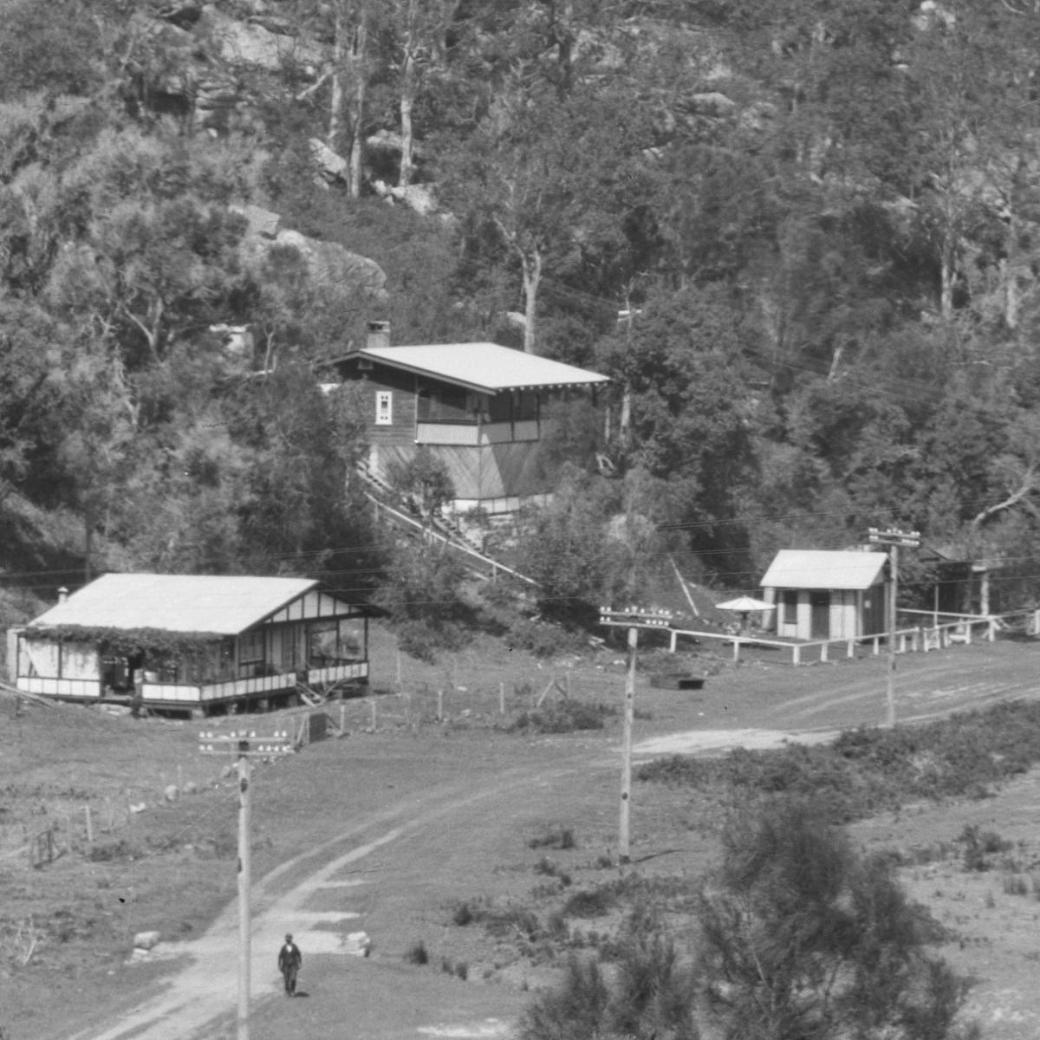
This house beside Albert Verrills house at Palm Beach may well be that advertised below:
PALM BEACH – furnished cottage for sale or will Let or Lease. 4rms. Kitch, verandah, 36x10. 5mins surf, boating and fishing. Good views. A VERRILLS, Palm Beach, Pittwater. Advertising. (1919, January 4). The Sydney Morning Herald(NSW : 1842 - 1954), p. 11. Retrieved from http://nla.gov.au/nla.news-article15818631
This is a section from: Panorama of Palm Beach and Pittwater, Part of Enemark collection of panoramic photographs [1917-1946], nla.pic-vn6195128, courtesy National Library of Australia.
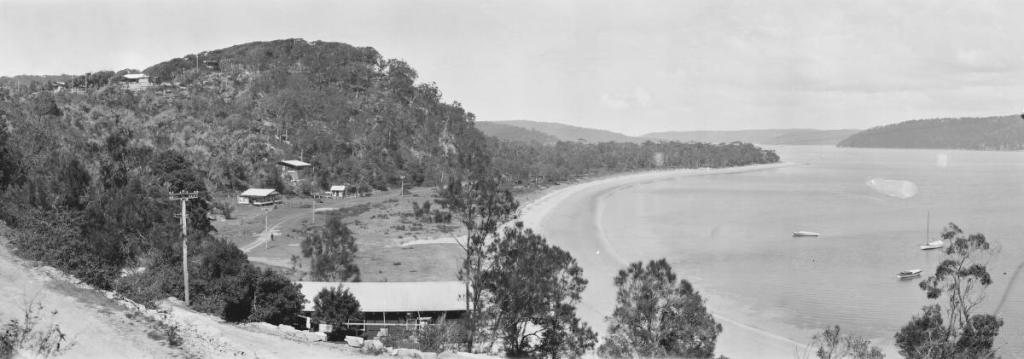


Extras:
NT Government - Northern Territory WWII Exhibition - Extensive ONLINE photographic collection: This online exhibition showcases some of the Library's rich holdings relating to the devastation and destruction inflicted on the Northern Territory during the Second World War, especially during the bombing of Darwin in 1942.
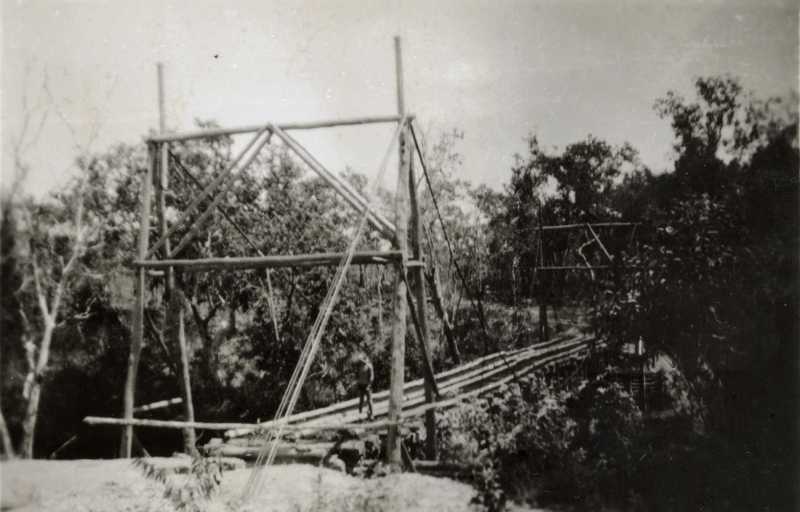
The Royal Australian Engineers (RAE) is a corps of the Australian Army (although the word corps does not appear in their name or on their badge). The RAE is ranked fourth in seniority of the corps of the Australian Army, behind the Staff Cadets, Armoured and Artillery Corps. The Corps was formed by the amalgamation of the various colonial engineer corps of the States and territories of Australia in 1902 and since then has served in various conflicts including World War I, World War II and the Vietnam War. The Corps has also served on numerous peacekeeping operations and is currently involved in the Australian contribution to the war in Afghanistan.
The RAE provides combat engineering, construction and other technical support to the Australian Defence Force. One of the main roles of the Corps is to provide mobility and counter mobility capabilities to the Australian Army and its allies. This means enhancing the ability of friendly forces to move while denying movement to enemy forces. In order to provide these capabilities, engineers are required to conduct many tasks including penetrating minefields, locating and disarming booby traps, purifying water and building roads and bridges. The Corps also performs the majority of the Australian Army's demolition tasks and is trained to fight asinfantry if needed.
The motto of the Royal Australian Engineers is Ubique (Everywhere), a motto shared with RAE's parent corps, the Royal Engineers. This motto was bestowed by King William IV in 1832 in recognition that both Sappers and Gunners were not entitled to carry Regimental Colours and typically served as small detachments instead of a whole unit.
The original motto of the RAE, adopted at Federation was Facimus et Frangimus (We make and we break) and appeared on the engineer hat badge up until 1947 when it was replaced by Honi soit qui mal y pense. It now only appears on the Corps Cipher.
The current Engineer hat badge features a leather garter adorned with a crown and the motto Honi soit qui mal y pense(Evil be to him who evil thinks), mirroring the motto of the Order of the Garter. This honour was awarded to the RAE in 1947 for their efforts during World War II.
Sappers
The Royal Australian Engineers also adopted the Royal Engineers practice of calling their private soldiers "Sappers", in recognition of the fact that the very earliest engineers had been primarily concerned with driving saps (tunnels) both towards the enemy lines, and underneath fortifications.
Colours
Although the Corps does not carry official Regimental Colours such as those carried by infantry units, the basic Royal Australian Engineers colours are blue and red. Typically, however, Unit Colour Patches, consist of a red feature on a purple field. The banner depiction of the colours consist of a red field with two horizontal blue bands near the top and bottom of the field.
Royal Australian Engineers. (2014, April 9). In Wikipedia, The Free Encyclopedia. Retrieved from http://en.wikipedia.org/w/index.php?title=Royal_Australian_Engineers&oldid=603452692
Below are a few items from a vast array of material that must exist not only in our own records but within the archives of those with whom Australia was once in conflict. Some of these point out the ironies of people in war times, others illustrate how we may be complacent and the opposite within the same day.
In the lead up to the centenary of World War I, the State Library of NSW's Digital Excellence Program has focused on digitising runs of NSW newspapers from rural and regional areas that were published during the years spanning the Great War (1914 – 1918). In addition to NSW newspapers, a State Library team of expert librarians has identified the most in-demand, fragile and valuable items from across the collection for digitisation, such as the Library’s collection of 1,100 World War I personal diaries which will be featured in a major exhibition from July.
This excellent project from one of our premier knowledge sharers of everything Australian may also remind us that in every nation involved in these horrific conflicts are families just like ours, whose sons and daughters may have been lost to them during these wars.
We would encourage to explore all available online already - there are resources for students, teachers and those who are lifelong students or have family members who served during that first 'war to end all wars'. The State Library of NSW page for this project, listing all parts, is HERE
COLOURED TROOPS KEEP HUGE DARWIN CONVOYS MOVING
By MERTON WOODS, Courier-Mail War Correspondent.
AMERICAN road convoys, manned by U.S. coloured soldiers, have travelled millions of miles in the last four months, carrying vital war supplies to the Darwin area and northern Australian bases. They have operated in addition to Australian convoys.
Already the Americans have carried many thousands of tons of cargo and have almost doubled the quantity of supplies going by road. The convoys are operated by the U.S. Army Quartermaster Corps' Motor Transport Command, leader of which is a colonel who is a World War 1 veteran and a lawyer. A brilliant organiser, with apparently inexhaustible energy and a personality which enables him to get the utmost out of his soldiers, he has made 'keep 'em rolling' his motto and has succeeded in 'keeping 'em rolling.' He claims that the millions of miles his trucks have travelled in four months constitutes a world's record. COLOURED TROOPS KEEP HUGE DARWIN CONVOYS MOVING. (1942, November 9). The Courier-Mail (Brisbane, Qld. : 1933 - 1954), p. 4. Retrieved from http://nla.gov.au/nla.news-article50151526
SINGAPORE REPORT - SINGAPORE, January 21.
A communiqué issued at 6.20 p.m. states: "Heavy fighting continued throughout yesterday in the Vakri and Bukit Payong area, in North-western Johore. Enemy aircraft were active during the day, making low dive-bomb-ing and machine-gun attacks on our forward troops. Fighters which carried out offensive sweeps yesterday inthe vicinity of Bakri in support of our troops encountered a formation of army type 97 planes, which pettisoned their bombs when intercepted. One enemy aircraft was shot down. In the Batu Pahat area contact with the enemy was slight. It is now reported that, during an action in the Bukit Payong area our artillery inflicted heavy casualties on the enemy at short range over open sights.
"On the east coast at the Endau out-post our troops have been withdrawn in the face of superior enemy forces. Mersing was again bombed and machine-gunned yesterday, with slight results.
90 HEAVY BOMBERS IN RAID
"Reports now show that the force of enemy aircraft which raided Singapore yesterday consisted of about 90 heavy bombers, escorted by fighters. The total casualties are now reported as 64 killed and 154 injured.
A number of heavy and successful attacks are being made on enemy-occupied aerodromes in Malaya during the night, by aircraft of the R.A.F. Extensive damage has been done to enemy aircraft, hangars and aero-drome buildings in Kuantan, which has been twice raided. During the first attack bombs dropped from a low altitude caused considerable damage on aerodromes. During this raid the British aircraft were attacked by enemy fighters, but all returned safely. In the later attack on Kuantan, which was also made without loss, sticks of bombs were dropped across hangars and caused large fires. Direct hits were made on aircraft.
"At Kuala Lumpur a successful bomb and machine-gun attack was made on the aerodrome. Here, also, direct hits were made on aircraft andat least three were set on fire. A number of other fires were started, including one which was seen increasing some time after the raid. One British aircraft is missing from this operation.
"Enemy aircraft again raided Singapore this morning and were intercepted by fighters, which destroyed four and damaged a number of others. The bombing once more appeared to be indiscriminate, a large number of bombs falling on residential areas. Details of the damage and casualties are not yet to hand. The anti-aircraft defences at Singapore brought down nine enemy aircraft this morning."
JAPANESE CLAIMS - NEW YORK, January 21.
The Tokyo official radio states: "The Domei agency claims that the Japanese are within six miles of Johore Strait. Large Japanese forces are advancing for a direct assault on Singapore. The Australian forces south of the Muar River have been pushed back towards Singapore, suffering heavy losses in their desperate resistance."
The Tokyo official radio claims that the Japanese attacking Cowmeander, north-east of Tavoy, annihilated resisting enemy units.
LONDON, January 21.
The Berlin radio quotes the following message from Tokyo: "Japanese raids caused considerable damage to military objectives. The Singapore naval station is reported to be on fire. The British are reported to have given up their efforts to extinguish the flames. Several oil tanks are also blazing."
According to the Italian radio, a Japanese communique states that the Japanese are only four miles from Johore Baru. Neutral sources are quoted for the statement that the Japanese southwards of the Muar River severely defeated the Australians' opposing advance.
The Domei agency states: "The Japanese have broken through the British first line of defence on the Thai-Burmese border and are advancing towards Moulemein."
NEW YORK, January 21.
The Tokyo official radio discloses that the Russian ambassador (M. Smetanin)will leave Tokyo for Moscow on Saturday.
RANGOON, January 22.
Fierce fighting is continuing in the Kawkareik area east of Moulmein. British bombers and United States fighters are participating.
Japanese forces invaded Burma from Thailand and are within 100miles of Rangoon, Burma's capital. Fierce fighting is raging between the Imperial troops and the invaders at Kawkareik, 45 miles east of the Burmese town of Moulmein.
RAIDS GROW IN VIOLENCE - SINGAPORE, January 22.
Mass air raids on Singapore are growing in violence. A hundred planes raided the island today, killing 304 people and injuring 625. There has been heavy fighting in North-eastern Johore, 80 miles from Singapore.
LONDON, January 22.
The British Broadcasting Corporation states that heavy fighting is proceeding 80 miles from Singapore. Hurricane fighters have rein-forced Singapore's air defences. Five Japanese bombers were shot down today, making a total of 18 in two days.
GOING GROW HARDER - TOKYO, January 21.
The Diet resumed after the recess. The Prime Minister (General Tojo) warned the country that although Britain and America had suffered defeat in the initial phase of the conflict, it was not difficult to imagine that they would stubbornly resist and try to turn the tide.
"We must, therefore, be prepared for the difficulties that may arise in the future," he added. "The Japanese nation must learn to deal with difficulties and tribulations until Japan, closely cooperating with Italy and Germany, can extend vigorous war operations until the United States and the British Empire are brought to their knees."
After warning Australia and the Netherlands East Indies that Japan would show them no mercy if they continued their resistance, he expressed regret that Chungking was still continuing a "meaningless resistance."
MORE EQUIPMENT VITAL
After long conferences with the chiefs of staffs of the three services, the War Cabinet decided today that the progress of the Japanese invasion of the Pacific could be arrested effectively only by a great increase in equipment resources in Australia.
The War Cabinet accordingly directed Mr Forde to send two telegrams, one to Mr Churchill and the other to President Roosevelt, emphasising the gravity of the threat to Australia and appealing for the immediate dispatch of war equipment. The Commonwealth Government made a special appeal for aircraft.
The message to Mr Churchill, it was stated tonight, was stated to have been unequivocally worded. It is believed to point out that Australia, when not in immediate danger, strained every resource to support parts of the Empire and Allied countries in more immediate need of war material. In consequence of the large quantity of equipment and the number of men sent to other theatres in the last two years Australia was now much less favourably situated to meet a Japanese attack than if the whole of the nation's resources had been marshalled and conserved for home defence.
The Australian Government, it was stated tonight, therefore expects and is confident that Britain and America will now come promptly and effectively to the assistance of the Commonwealth.
It is announced officially that 888 women and children were evacuated from New Guinea in nine days by a fleet of air liners. A plane which usually carries 21 passengers lifted 53 on one trip, 20 of whom were women and the remainder children. On another trip the plane carried 48. The planes used are well known on interstate services, among them being the Kyilla and the Kurana. The work of evacuation, which began on December 21, was completed on December 29.
"MUST EXPECT ATTACK"
"I am certain that the enemy will attack the Australian mainland, perhaps not at once but soon," said the Minister for the Army (Mr Forde) in a nation-wide broadcast tonight. "If the attack comes we are ready. We shall give battle to the best of our ability wherever we find him. We shall never give in."
The Japanese were attacking within bombing range of the mainland, he said. Just as a time and a day were marked against Hawaii on the Japanese war plans, so a time and day were marked against the towns and cities of Australia.
For the first time in the history of Australia her territory had been attacked and the A.I.F. could proudly welcome the militia men as their equal comrades in arms. No one theatre where the enemy might strike was less important or had any less bearing on the ultimate result than any other. Everywhere he had struck his strategy, method, and purpose had been the same.
"We have always emphasised that the battle of the Pacific is the battle that can as easily lose the entire war as any battle in which the Allied forces are engaged," said the Minister. "The war factories of Britain and America depend upon the Allied countries of the Pacific for all materials. Only by keeping the Pacific open can those vital supplies continue to flow. The battle of the Pacific is the battle for Australia. What we have impressed on the people throughout the Empire is that, had there been sufficient forces, sufficient arms, tanks, guns, bombers, and fighters in Malaya the battle of the Pacific need not, at this stage, have become a battle for Australia."
Mr Forde continued: "We have no time to argue now whether this thing or that should have happened. We have only time to strengthen our purpose and determination that what has been lost will be regained and that where the Japanese have advanced they will retreat over the scorched earth they have produced.
"This is no time for stoppages of work, whether they are created by pro-vocative and recalcitrant employers or irresponsible employees. The result to the country is the same. The penalty must be the same."
" The "Daily Mail" publishes a map on its front page, headed "Australia's Danger," showing arrows from the Celebes Sea and from Port Moresby to Darwin, also from Port Moresby and Kieta to Cairns, also semi-circles marked "land an inch from the sea" from Cairns to Melbourne, with a black type caption: "The map shows the grave menace that has developed to Australia and the ultimate invasion drive down the rich well-populated east coast, which, it is feared, may follow.
Such an attack could be launched, either from the Solomon Islands or New Guinea, and would develop with
simultaneous landings from the sea,like another Malaya on a much bigger scale.
"On the other hand, the Japanese movement to the Solomon Islands may mean no more than the seizure of
sea bases to cut Australia's reinforcement lines from America, and endanger America's own reinforcement lines to Singapore, via Australia. The achievement of either objective would be sufficiently grave.
"An attempt might also be made to seize Darwin to serve as the Japanese first base in the Indian Ocean and as a barrier between Australia and the Dutch East Indies. A Japanese land attack across the bitter Australian desert is not impossible to Asiatic troops, but is unlikely. A possible land objective from Darwin would be the western goldfields."
BLACKOUT OF DARWIN - DARWIN, January 23.
A complete blackout of Darwin and an area within a radius of 80 miles has been ordered by the military authorities. Vessels in port have also been ordered to black out all lights. Traffic speed has been reduced to 15 miles an hour. THE WAR IN THE PACIFIC. (1942, January 29). The Central Queensland Herald (Rockhampton, Qld. : 1930 - 1956), p. 9. Retrieved from http://nla.gov.au/nla.news-article76232910
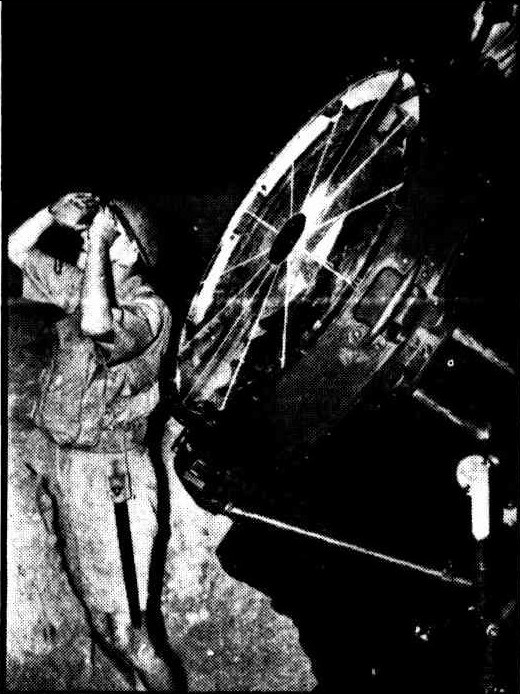 DARWIN VIGILANT - DAY AND NIGHT the eyes of the defenders of Darwin are turned skywards, keeping watch for hostile aircraft. In this picturea Darwin Digger is seen manning a searchlight, part of an antiaircraft unit. DARWIN VIGILANT. (1942, February 19). The Courier-Mail(Brisbane, Qld. : 1933 - 1954), p. 3. Retrieved from http://nla.gov.au/nla.news-article50116035
DARWIN VIGILANT - DAY AND NIGHT the eyes of the defenders of Darwin are turned skywards, keeping watch for hostile aircraft. In this picturea Darwin Digger is seen manning a searchlight, part of an antiaircraft unit. DARWIN VIGILANT. (1942, February 19). The Courier-Mail(Brisbane, Qld. : 1933 - 1954), p. 3. Retrieved from http://nla.gov.au/nla.news-article50116035
Darwin Bombed - SYDNEY, Thurs. — First bombs ever to hit Australia fell on Darwin this morning as Japanese raiders struck their most southerly blow of the war.
It has not yet been revealed how heavy the bombing was or what damage resulted. News of the attack was transmitted soon after to Prime Minister Curtin, who made the following announcement early this afternoon:—"I have just been advised by the Department of Air that a number of bombs were dropped on Darwin this morning. "Extent of the raid and the results of the attack are not yet known." Steps are being taken to obtain all relevant details." As soon as these are known a further announcement will be made." Australia has now experienced physical attack.
"Complete Giving"
"As head of the Government I need only say that total mobilisation is the Government policy for Australia." Until the time elapses when measures can be put into effect, Australians must answer the Government's call of complete giving to the nation."
The statement of Darwin's bombing is official. Nothing has been hidden and there is no call for any rumour." If rumours circulate, take no notice of them. Deal sharply with any person who circulates them." The Government has told you the truth.
"Face it as Australians."
Attack on Darwin has been anticipated by the Commonwealth Government for some time — in fact ever since Japan secured foot-holds in New Guinea (by seizing Rabaul) and in Amboina. It is believed that the attack occurred about 10 a.m. A radio message timed 10.5 a.m. was received from Darwin postal authorities stating: "Air raid Darwin started. P.M.G. radio station closing down."
Further news by overland telegraph is awaited. No report has reached Federal authorities from military commander Major-General Blake. Officials were instructed today to obtain full information as soon as possible so that it could be conveyed to Mr. Curtin for a further announcement. Mr. Curtin received news of the bombing in St. Vincent's Hospital, where he is still a patient.
PLANS UNCHANGED
It is not expected that the news will change his plans. He appeared better today and his staff anticipates that he will be able to leave tomorrow for Canberra to attend Parliament's secret session.
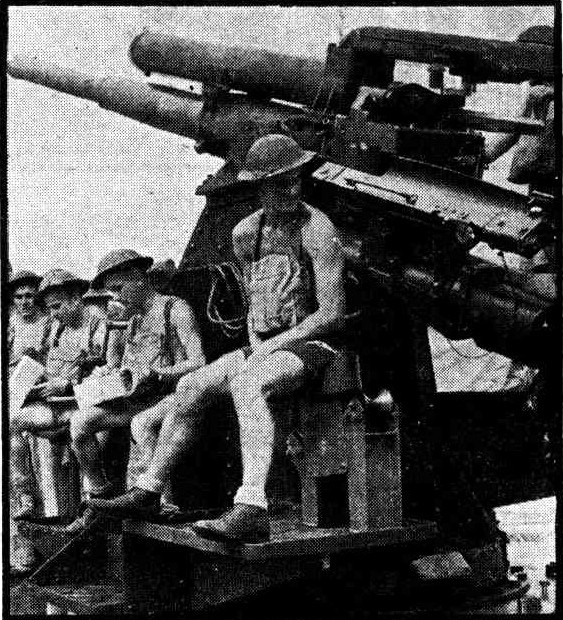 Point to his recent appeal for a united Australian front against Japanese encroachment is given by this morning's attack. He will now be able to face the House with the knowledge that a Japanese attack on Australia is no longer a remote contingency but is actually happening and that the easy optimism of some people who believed that Japan would not bother Australia is completely unjustified. The Advisory War Council concluded its sittings in Sydney today. Deputy-Prime Minister Forde said that the latest operational reports concerning the position in the South West Pacific war zone had been fully considered. He would make no further comment. Chiefs of the various defence services were present at the council meeting and took part in the consultations. Darwin people have thought bombs were coming before: on January 2, because of confusion over an alert; on January 26, when an anti-aircraft gun fired as an incoming plane failed to give the right signal; and on February 8,when an unofficial military explanation of a one and three-quarter-hour alarm was that 40 Jap bombers were reported to be heading for Darwin. The last time a number of fighters were seen flying out to sea, returning an hour and a half later at a great height. An unconfirmed report said a Jap aircraft carrier had been sighted some hundreds of miles out. ONE of Darwin's anti-aircraft guns, probably in action against Japanese bombers this morning. Darwin Bombed. (1942, February 19). The Daily News (Perth, WA : 1882 - 1950), p. 1 Edition: CITY FINAL. Retrieved from http://nla.gov.au/nla.news-article78571493
Point to his recent appeal for a united Australian front against Japanese encroachment is given by this morning's attack. He will now be able to face the House with the knowledge that a Japanese attack on Australia is no longer a remote contingency but is actually happening and that the easy optimism of some people who believed that Japan would not bother Australia is completely unjustified. The Advisory War Council concluded its sittings in Sydney today. Deputy-Prime Minister Forde said that the latest operational reports concerning the position in the South West Pacific war zone had been fully considered. He would make no further comment. Chiefs of the various defence services were present at the council meeting and took part in the consultations. Darwin people have thought bombs were coming before: on January 2, because of confusion over an alert; on January 26, when an anti-aircraft gun fired as an incoming plane failed to give the right signal; and on February 8,when an unofficial military explanation of a one and three-quarter-hour alarm was that 40 Jap bombers were reported to be heading for Darwin. The last time a number of fighters were seen flying out to sea, returning an hour and a half later at a great height. An unconfirmed report said a Jap aircraft carrier had been sighted some hundreds of miles out. ONE of Darwin's anti-aircraft guns, probably in action against Japanese bombers this morning. Darwin Bombed. (1942, February 19). The Daily News (Perth, WA : 1882 - 1950), p. 1 Edition: CITY FINAL. Retrieved from http://nla.gov.au/nla.news-article78571493
Invasion of Australia
A paper on "The Local Government Engineer and National Defence" was read at the conference of the Institute of Australian Local Government Engineers at Melbourne on Wednesday, by Mr. G. A. Taylor, the general secretary, who is also a captain in the' Australian Intelligence Corps.
Referring to the possibility of the invasion of Australia, he said that some time ago a distinguished Japanese officer, who had fought in the recent war with Russia, had been discovered making surveys of several vulnerable portions of the New South Wales coast. Only a month ago at Prospect, near Sydney, a party of Germans were arrested while making plot surveys of natural features. Reports from Sydney in connection with Mr. Taylor's sensational statements show that the Germans referred to were shadowed and arrested by a small party of the Australian Intelligence Corps, and their belongings seized. They were released, subsequently, however, as under existing laws there is no authority to arrest for espionage unless the suspected persons are surprised in making maps or surveys on a military reserve. The party of Japanese also referred to by Mr. Taylor were discovered accidentally by a party of Easter campers in the vicinity of Barrenjoey. They had with them a plane table and military survey instruments. They apparently could speak very little English. The case was reported to the authorities, and it was subsequently ascertained that the men were officers, one of very high standing, and they could all speak English very well, and were known to have been in constant communication with Japan during the time they have been in Australia. It was also found that they had succeeded in making an elaborate and extensive military survey of the country around Broken Bay. Their movements were closely watched, and it is understood that they have since returned to Japan. Invasion of Australia. (1912, November 3). Sunday Times(Perth, WA : 1902 - 1954), p. 5 Section: Second Section. Retrieved from http://nla.gov.au/nla.news-article57741196
Back from Darwin - Mr. Dan O'Brien tells Of Raids
It is six and a half years since Mr. Dan O'Brien left Renmark for Darwin. He returned to Renmark a short while ago on leave. He was linesman for six years in Renmark and seven years at Waikerie. His activities extended over a big proportion of the Murray Valley districts and he with others accomplished a great work in the Postal Department. He was a contempory with Mr. R. Walsh in the River districts for about 20 years in all.
Arriving in Darwin with his wife and four children he was promoted an inspector and as such had to travel about on telegraph line work a great deal. On December 19 of last year his wife and family were evacuated from Darwin by order, and came to live with his wife's mother in Renmark.
He was in the Darwin Post Office when that place received a direct hit from a bomb, killing the postmaster and other postal assistants and wounding others Mr. O'Brien told the story of the raid by 72 Japanese planes and the havoc they caused leaving in their trail hundreds of dead and wounded.
'I was in the engineer's office when the planes came over," he said. "I was working out details of line work". He described the siren warnings and how by some mistake they had not the slightest indication that the planes coming over were enemy planes.
"When we knew what was, happening," he said, "we made for slit trenches. Bombs fell all round us. Debris flew in all directions The Japanese evidently meant to have us. They bombed and then waited for the dust to clear before dropping more bombs. They came over in groups of four and kept this up. They came in from the east in relays and no warning was given from Bathurst Island. We had expected this warning but it never came.
Militia were at their battle stations at once said Mr. O'Brien and here I want to pay a compliment to the Militia gunners serving the A.A. guns. Their work was magnificent. They stuck to their guns like good Australians. They never flinched and with bombs falling all round, they carried on. They deserve these words of mine and every one of the gunners did his duty as if they were old and experienced soldiers.
"Other troops stood to arms and remained at their posts throughout the raid. They were in positions some way out of the town."
Strange to say not such a great deal of damage was done to buildings in the first raid Mr. O'Brien explained, but 11 were killed where he was in the postmaster's yard. Then came further raids when the Japs concentrated on the aerodrome with bursts of machine gun fire. They swept round and bombed the hospital eight miles from the town and when they came back over Darwin the A.A. gunners let them have it again and again. The Japs knew all about Darwin, he said. They had had the full run of the place and our coastline for many years.
Mr. O'Brien went through other raids and at another aerodrome saw three raiders shot down by Americans using Kitty Hawk planes. The Americans went up intercepted and down came three Japs.
Then came a journey far from Darwin on his perilous duty. It was a clear day. The Japs flew over at a great height. They dropped a wind gauge. Down came' some bombs and the only casualty was one Aboriginal killed.
Mr. O'Brien paid a high compliment to the efficiency of the Americans he met. They were always on their job, he said, and worked with fine intelligence. "We are lucky to have them with us I can tell you." He paid a great tribute to the units of the Australian navy and the work they had carried out during a very trying time. Back from Darwin. (1942, June 25). Murray Pioneer and Australian River Record (Renmark, SA : 1913 - 1942), p. 1. Retrieved from http://nla.gov.au/nla.news-article109266168
Rebuilding of Darwin - before and after WW II
In 1937 a cyclone caused extensive damage to this northern Australian city – plans to rebuild the city then were subject to a series of ‘debates’ in good old Australian word skirmish style, that went on for a number of years. Although A.I.F. engineers rebuilt as needed what was damaged during WWII – a series of articles after hostilities had ceased – indicate that a return to the ‘debate’ ensued, with one report of 1945 stating that a world wide competition would be launched to decide on the planners and the best plan.
By 1946 the ‘debate’ was getting more frenetic:
DARWIN MOVE ON REBUILDING PLAN
DARWIN.-A meeting of freehold property owners will be held in Darwin tomorrow night to discuss what action will be taken to oppose the Darwin Acquisition Act and the plan for rebuilding the town. THE meeting is being organized by some of the town's wealthiest men, who regard the Act as a threat to the re-establishment of private enterprise, which is already struggling hard under adverse conditions to get a foothold. The decision to discuss what action should be taken has been precipitated by the Government's exclusion from the Acquisition Act of the defunct meat works owned by Vestey's, and the attack launched on the rebuilding plan in Adelaide by the member for the Northern Territory, Mr. Blain. Mr. Blain, who is due in Darwin this week on his first official visit-since his release as a prisoner of war, is bringing with him a copy of a plan prepared in 1937 by the then town planner of Brisbane (Mr.R. A. McInnes).Many business people in the town believe the McInnes plan could be better fitted to the needs of Darwin in its present shape.
In the meantime, former residents are unable to obtain any information about the new plan. A number of them would like to begin building business premises immediately, but they claim they can get no satisfaction from either the administration or the Department of Works and Housing about new building sites. A number of old residents, including some born and bred in Darwin. have declared that it will take more than the Government rebuilding plan to shift them from their homes. One woman said today: "They'll have to come and get me with a dray before I'll shift." DARWIN MOVE ON REBUILDING PLAN. (1946, February 18).News (Adelaide, SA : 1923 - 1954), p. 4. Retrieved from http://nla.gov.au/nla.news-article128343728